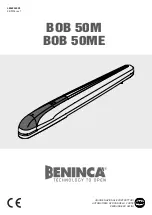
5
A
: IMPORTANT INSTALLATION NOTES
(operator reversing feature, edges, photocells) ARE
OPERATING and install VEHICLE DETECTOR LOOPS AND
VEHICLE DETECTORS for protection of user vehicles. Read
the manual for information on the installation of these devices. IF
VEHICLE DETECTOR LOOPS HAVE BEEN INSTALLED TO
PREVENT THE GATE FROM CLOSING ON A VEHICLE,
INSTRUCT THE USER TO PERIODICALLY CHECK THE
OPERATION OF THE DETECTORS.
•
Make sure the gate moves freely, all hinges are in good working
order, the gate does not bind in any manner and the gate swing
area is clean and free of irregularities.
•
The HDSLG 1000 is shipped from the factory with the sprocket
guard in place. When operating the gate with the operator’s outer
cover removed, STAY CLEAR OF THE DRIVE SPROCKET
AND IDLER PULLEYS. THESE PINCH POINTS WILL NOT
BE PROTECTED WHEN THE COVER IS REMOVED.
NEVER LEAVE THE INSTALLATION WHEN THE COVER
IS REMOVED AND THE GATE MAY BE OPERATED.
•
NEVER LEAVE THE INSTALLATION WHEN THE
SPROCKET GUARD IS REMOVED.
•
When the metal cover of the control box is removed, 115 Volts
AC will be exposed on the control board AS LONG AS THE
MAIN POWER SWITCH IS ON. EVEN IF THE RED POWER
LIGHT ON THE CONTROL BOARD IS NOT LIGHTED, 115
VOLTS AC WILL STILL BE PRESENT ON THE CONTROL
BOARD. NEVER LEAVE THE INSTALLATION WITH THE
COVER OF THE CONTROL BOX REMOVED.
•
ALWAYS TURN OFF THE POWER BEFORE REPLACING
THE SNAP-IN FUSES ON THE CONTROL BOARD.
•
DO NOT TRIM THE PLASTIC SPROCKET GUARD COVER
MORE THAN IS NECESSARY TO CLEAR THE ENTRANCE
AND EXIT OF THE CHAIN. THERE ARE SCORE MARKS
ON THE COVER FOR THE PROPER “CUT-OUT”. UL Listing
was obtained with the sprocket guard cover trimmed as marked
on the cover. You may void the UL Listing and increase the
pinch hazard if the trim lines are not followed..
•
DO NOT INSTALL THE OPERATOR UNTIL ALL GATE
PROBLEMS HAVE BEEN CORRECTED.
•
DO NOT consider the built in overload detector as the primary
obstruction sensing system. Consider all options in the gate
system design.
•
DO NOT connect any auxiliary equipment to the operator
(detectors, card readers, etc.) until the gate operator and all its
functions are fully tested. Only connect one device at a time and
ensure its proper function(s) before moving on to the next device.
•
Install the operator on the inside of the property/fence line. DO
NOT install an operator on the public side of the fence line or
gate.
•
IDENTIFY THE ENTRAPMENT ZONES AND PINCH POINT
AREAS PER FIGURE 4. Design the gate installation to
minimize the risk of entrapment in these areas. Install additional
safety equipment such as four wire edges and photocells to
further minimize risk. All entrapment zones are required to be
protected.
AS THE INSTALLER YOU ARE RESPONSIBLE FOR:
•
ASSURING THAT THE OWNER/END USER OF THE
SYSTEM UNDERSTANDS ITS BASIC OPERATION AND
SAFETY FEATURES. IN PARTICULAR, BE SURE THE
OWNER/END USER UNDERSTANDS THE LOCATION AND
OPERATION OF A MANUAL DISCONNECT (WHERE
PROVIDED) OR HOW TO OPERATE THE GATE
MANUALLY.
•
POINTING OUT TO THE OWNER/END USER OF THE
GATE SYSTEM THAT CHILDREN OR PETS ARE NOT
ALLOWED TO PLAY ON OR NEAR THE GATE, FENCE OR
ANY PART OF THE SYSTEM, AND THAT THE SAFETY
INSTRUCTIONS SUPPLIED WITH THIS OPERATOR AND
THEIR IMPLEMENTATION ARE THE RESPONSIBILITY
OF THE OWNER/END USER.
•
LEAVING THE INSTALLATION AND MAINTENANCE
MANUAL FOR THIS OPERATOR AS WELL AS ANY
ADDITIONAL SAFETY INFORMATION SUPPLIED WITH
THIS OPERATOR OR OTHER COMPONENTS OF THE
GATE SYSTEM WITH THE OWNER/END USER.
•
NOT PLACING IN SERVICE THIS OPERATOR IF YOU
HAVE ANY QUESTIONS ABOUT THE SAFETY OF THE
GATE OPERATING SYSTEM. CONSULT THE OPERATOR
MANUFACTURER.
SLIDE GATE ENTRAPMENT PROTECTION
Use the illustration at left to minimize the risk of injury in your design
of the swing gate operator system.
Entrapment Zones:
Design in personal entrapment protection devices
to protect people from entrapment in the zones shown. Install vertical
posts with gate edges attached on both sides of the gate to prevent body
entrapment. Gate edges should be wired to stop the gate upon contact.
Pinch Points:
Attach roller guards in cantilevered gate systems to
minimize the risk of hands being caught between the top of the gate and
the roller.
106709
Figure 4






































